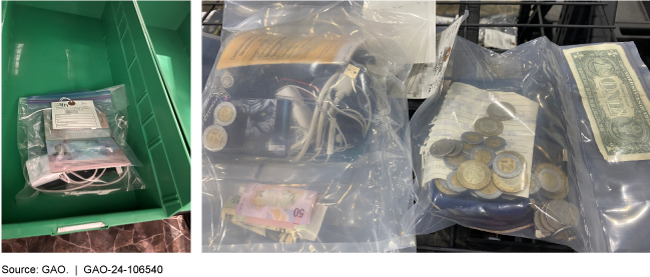Southwest Border: Additional Guidance and Monitoring Needed to Improve CBP's Handling of Personal Property
Fast Facts
Customs and Border Protection may hold noncitizens in short-term custody in facilities along the southwest border. CBP is to collect their personal property, store it, and return it when they're released.
CBP has guidance for handling personal property, but some of it is unclear, resulting in field locations interpreting it differently. For example, some locations discard property over a certain amount or size, while others don't. Also, field locations' instructions for people to retrieve their personal property after release are inconsistent.
CBP also doesn't monitor how locations implement its guidance.
We recommended addressing these issues.
Examples of bag sizes used to store personal property at Border Patrol facilities

Highlights
What GAO Found
U.S. Customs and Border Protection (CBP) and its components—U.S. Border Patrol and the Office of Field Operations—have policies and procedures for how its personnel are to handle the personal property of individuals held in custody, and the components have taken action to implement this guidance. For example, GAO observed CBP personnel searching and storing individuals' personal property at short-term holding locations. However, GAO found that Border Patrol locations interpret the guidance differently, including definitions of health hazards and the amount and type of property field locations should collect and store.
Property Storage Rooms at Two Border Patrol Facilities, July and September 2023

Note: These photographs illustrate the amount of personal property stored in storage rooms at the two facilities at the time of our visits. The photo on the left is of a facility that did not limit the amount of personal property an individual may store, whereas the photo on the right is of a facility that limits personal property.
According to Border Patrol headquarters officials, field locations interpret the guidance differently because it does not define key terms and concepts. Border Patrol headquarters also does not monitor implementation of guidance at the field level. By issuing clarifying guidance on handling personal property and developing and implementing a mechanism to monitor its implementation, Border Patrol would be better positioned to ensure personal property is handled consistent with agency guidance.
In addition, CBP policies and procedures state that individuals are to be notified of CBP's process for claiming personal property upon release from custody. GAO found that Border Patrol and the Office of Field Operations field locations do not consistently communicate this information to individuals. By providing written instructions, CBP would be better positioned to communicate procedures to individuals released from custody to better allow them to retrieve their property.
Why GAO Did This Study
In fiscal year 2023, the Department of Homeland Security's CBP encountered nearly 2.5 million individuals at the southwest border. CBP holds individuals in short-term custody in holding facilities located along the border. When individuals enter short-term custody, CBP personnel must search, collect, store, and transfer or return their personal property. Property deemed to be contraband or hazardous is to be discarded. Individuals and representatives from nongovernmental organizations have raised concerns about CBP personnel not returning or improperly discarding personal property of individuals in custody along the southwest border.
GAO was asked to review CBP's policies and procedures regarding the handling of personal property. Among other things, this report assesses the extent to which CBP has developed and implemented policies and procedures for handling personal property. GAO analyzed policies and procedures for handling personal property. GAO also interviewed officials and conducted site visits to 16 CBP facilities in Arizona, California, and Texas.
Recommendations
GAO is making three recommendations to CBP. These include that Border Patrol issue clarifying guidance for the handling of personal property and develop a mechanism to monitor implementation of this guidance, and that CBP develop and provide to individuals written instructions regarding property retrieval after their release from custody. DHS concurred with the recommendations.
Recommendations for Executive Action
| Agency Affected | Recommendation | Status |
|---|---|---|
| United States Customs and Border Protection | The Chief of Border Patrol should issue clarifying guidance for the handling of personal property that defines key terms and concepts, including addressing the amount of property that sectors and facilities should collect and store, the types of property that may or may not be discarded, and steps for transferring and returning property. (Recommendation 1) |
When we confirm what actions the agency has taken in response to this recommendation, we will provide updated information.
|
| United States Customs and Border Protection | The Chief of Border Patrol should develop a mechanism to monitor how sectors and facilities implement guidance for the handling of personal property. (Recommendation 2) |
When we confirm what actions the agency has taken in response to this recommendation, we will provide updated information.
|
| United States Customs and Border Protection | The Commissioner of CBP should ensure that upon release from CBP custody, individuals are provided written instructions explaining how to retrieve any lost or left behind personal property, including information specific to the facilities in which they were held. (Recommendation 3) |
When we confirm what actions the agency has taken in response to this recommendation, we will provide updated information.
|
